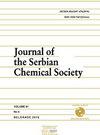Synthesis of and theoretical research on some azine derivatives and investigation of their antimicrobial activities
IF 1
4区 化学
Q4 CHEMISTRY, MULTIDISCIPLINARY
引用次数: 0
Abstract
This study includes experimental, theoretical, and antimicrobial investigations on 1-(diphenylmethylene)-2-(4-methoxybenzylidene)hydrazine (5), 1-(3,5-dimethoxybenzylidene)-2-(diphenylmethylene)hydrazine (6) and 1- (diphenylmethylene)-2-(2,3,4-trimethoxybenzylidene)hydrazine (7). The structures of the compounds synthesized by microwave method were determined by spectroscopic methods and elemental analysis. Conformational analysis, ground state structure, fourier transform infrared spectra (FT-IR), and nuclear magnetic resonance (NMR) spectra of the compounds were computed using density functional theory (DFT) calculations in the theoretical research. Based on the B3LYP/6-31G(d,p) level, the conformers from the torsional barrier scanning were optimized. The B3LYP/6-311++G .(d,p) was used to determine the harmonic vibrational frequencies, potential energy distribution (PED), infrared intensities, and NMR chemical shifts of the most stable conformers. The experimental findings were compared with theoretically expected spectral data. The antibacterial activity of the prepared compounds was tested in vitro against nine bacteria and one yeast species. The antimicrobial activity of the compounds was tested by minimum inhibitory concentration (MIC) and agar well diffusion method. Compound 7 showed good activity against the bacteria and yeast, while 5 and 6 showed no antimicrobial activity. Compound 7 showed zone of inhibition values in the range of 10-15 mm against Klebsiella pneumonia, Pseudomonas aeruginosa and Salmonella typhimurium The results indicated that compound 7 was effective against bacteria.一些嗪类衍生物的合成、理论研究及抗菌活性的研究
本文对1-(二苯基亚甲基)-2-(4-甲氧基苄基)肼(5)、1-(3,5-二甲氧基苄基)-2-(二苯基亚甲基)肼(6)和1-(二苯基亚甲基)-2-(2,3,4-三甲氧基苄基)肼(7)进行了实验、理论和抗菌研究。用微波法合成的化合物的结构通过光谱分析和元素分析进行了确定。在理论研究中,采用密度泛函理论(DFT)计算了化合物的构象分析、基态结构、傅里叶变换红外光谱(FT-IR)和核磁共振光谱(NMR)。基于B3LYP/6-31G(d,p)水平,对扭转势垒扫描的构象进行了优化。利用B3LYP/6-311++G .(d,p)测定了最稳定构象的谐波振动频率、势能分布(PED)、红外强度和核磁共振化学位移。实验结果与理论预期的光谱数据进行了比较。对所制备的化合物进行了体外抑菌活性试验,对9种细菌和1种酵母菌进行了抑菌活性试验。采用最低抑菌浓度法(MIC)和琼脂孔扩散法检测化合物的抑菌活性。化合物7对细菌和酵母菌有较好的抑菌活性,而化合物5和6无抑菌活性。化合物7对肺炎克雷伯菌、铜绿假单胞菌和鼠伤寒沙门菌的抑制范围在10 ~ 15 mm范围内,表明化合物7具有较好的抑菌效果。
本文章由计算机程序翻译,如有差异,请以英文原文为准。
求助全文
约1分钟内获得全文
求助全文
来源期刊
CiteScore
1.80
自引率
0.00%
发文量
76
审稿时长
1 months
期刊介绍:
The Journal of the Serbian Chemical Society -JSCS (formerly Glasnik Hemijskog društva Beograd) publishes articles original papers that have not been published previously, from the fields of fundamental and applied chemistry:
Theoretical Chemistry, Organic Chemistry, Biochemistry and Biotechnology, Food Chemistry, Technology and Engineering, Inorganic Chemistry, Polymers, Analytical Chemistry, Physical Chemistry, Spectroscopy, Electrochemistry, Thermodynamics, Chemical Engineering, Textile Engineering, Materials, Ceramics, Metallurgy, Geochemistry, Environmental Chemistry, History of and Education in Chemistry.

 求助内容:
求助内容: 应助结果提醒方式:
应助结果提醒方式:


